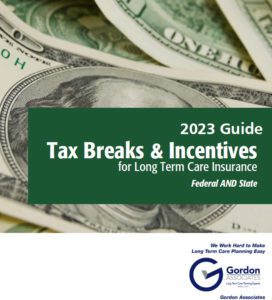You’ve heard about Long Term Care Insurance (LTCI), but do you really know what it is, not to mention if you need it? Here’s a brief intro to Long Term Care Insurance to help you get started.
LTCI reimburses policyholders a fixed daily or monthly amount when they require assistance with two of six specific activities of daily living or because of cognitive impairment due to Alzheimer’s disease. The six activities of daily living are: bathing, feeding, dressing, toileting, transferring and maintaining continence.
When purchasing an LTCI policy, you’ll select from a range of care options and benefits that cover long term care services in a variety of settings. The cost is determined by your age, health, and the benefits you choose. Some carriers also factor in family health history.
Designing Your LTCI Plan
With LTCI, you have many plan choices to make. Will you self-insure a certain amount of risk, or will your policy serve as your primary LTC funding vehicle? That decision will drive many of your design choices.
First, you’ll choose your monthly benefit (how much you want covered). Benefits range from $1,500 to $12,000/month, depending on the insurance carrier.
You’ll also choose your benefit period (how long you will receive benefits). Benefit periods range from 2 to 6 years, again depending on the carrier. A few carriers offer up to a 10 year benefit period.
Then you’ll choose your elimination period (the equivalent of a deductible), which can range from 0 to 365 days.
There are numerous optional LTCI benefits, but one to consider is an inflation protection rider, which increases benefits over time to keep pace with the cost of living. The most popular riders are 5% simple inflation, 3% and 5% compound inflation, and a future purchase option.
What LTCI Covers
Virtually all policies are comprehensive plans, which cover care provided in many settings: at home, adult day care centers, assisted living facilities, nursing homes, and Alzheimer’s facilities. A home care benefit will typically cover skillednursing care and occupational, speech, physical, and rehabilitation therapy. Most importantly, it can help with personal care, such as bathing and dressing.
Assisted living housing is a choice that provides personal care support services such as meals, medication management, bathing, dressing and transportation. In many cases, assisted living facilities will allow residents to bring their own bed, furniture and personal items.
A skilled nursing facility provides a high level of care and is primarily for rehabilitation. It requires the daily involvement of RNs and/or physical therapists.
Today, most long term care is received at home or in assisted living facilities.
How Do You Know What You Need?
Many people wonder whether to self-insure (i.e., plan to pay any future long term care costs out of pocket) or obtain LTCI. Rule of thumb: if you have a net worth of more than $2 million, it’s possible to self-insure. But that doesn’t mean it’s your best solution. For example, if your assets are not liquid, can you afford to pay care out of your income? Conversely, if you have limited assets and income, LTCI may not make sense for you. There are Medicaid solutions available for people with limited income and assets.
When Should You Buy LTCI?
The younger and healthier you are, the more eligible you are likely to be when you apply for LTCI. Start looking at LTC options around age 50, when you are likely to be in relatively good health. Today, the average applicant is 57. (20 years ago, the average applicant was 77!) Of course, you can start planning before 50, provided you have savings and a retirement plan and your financial house is in order.
In short, purchasing LTCI is a personal decision. Each individual or family must look at the risks, costs and benefits, and then determine if long term care insurance is a smart way for them to achieve protection and peace of mind.
If you have more questions, you can contact us or request a quote.


 To help determine if long-term care (LTC) insurance is right for you, we are offering a FREE informational guide. This is a comprehensive booklet that will answer many of your questions about tax breaks and incentives for LTCI for federal and state taxes.
To help determine if long-term care (LTC) insurance is right for you, we are offering a FREE informational guide. This is a comprehensive booklet that will answer many of your questions about tax breaks and incentives for LTCI for federal and state taxes. To help determine if long-term care (LTC) insurance is right for you, we are offering a FREE informational guide. This is a comprehensive booklet that will answer many of your questions about LTC and assist you with your health care planning.
To help determine if long-term care (LTC) insurance is right for you, we are offering a FREE informational guide. This is a comprehensive booklet that will answer many of your questions about LTC and assist you with your health care planning.